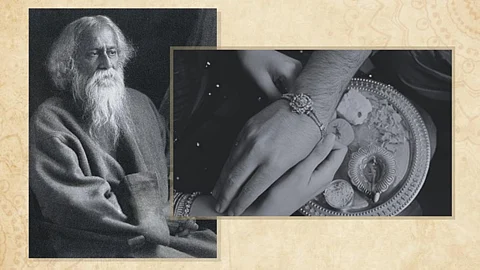
- HOMEGROWN WORLD
- #HGCREATORS
- #HGEXPLORE
- #HGVOICES
- #HGSHOP
- CAREERS
- ABOUT US
- CONTACT US

The festival of Raksha Bandhan stands as a time-honored tradition, symbolizing the cherished bond between siblings. Rooted in Indian history, mythology, and folklore, Raksha Bandhan's essence lies in a sister's gesture of tying a protective amulet around her brother's wrist, a talisman against harm. This timeless practice emanates from the desire to safeguard one another—siblings united by a bond that time and circumstance cannot fray. As sisters all over our nation tie a love-infused thread on their brother’s wrists today, we examine a famous re-interpretation of this historic festival. The profound metamorphosis of this festival was the brainchild of Nobel Laureate and arguably the greatest Bengali poet ever, Rabindranath Tagore.
The year 1905 brought seismic shifts to India's socio-political landscape, with the British government orchestrating the partition of Bengal and Bangladesh. In June 1905, a pivotal decision took shape during a meeting between Lord Curzon and a delegation of Muslim representatives in Assam. This encounter marked a turning point, as the Muslim delegates embraced the notion of a separate state, seeing it as a means to preserve their distinct identity. The blueprint on the table aimed to carve out a partition, cleaving the regions where Hindus formed the majority – West Bengal, Bihar, and Odisha – from the zones dominated by Muslims, specifically Assam and Sylhet.
With a stroke of bureaucratic authority, the British administration sanctioned the partition orders in August of the same year. The ramifications of this decision reverberated on October 16, when the new divisions came into effect. Remarkably, the date of the partion's sanction intersected with the month of Shravan, a period sacred to the Hindu community and marked by the celebration of Raksha Bandhan.
In a stroke of strategic genius, Rabindranath Tagore harnessed the spirit of Raksha Bandhan to mount a symbolic resistance against the British partition policy. Drawing upon the concepts of fraternity, unity, and the symbolic thread of protection, Tagore envisioned an image of communal harmony. By leveraging the very essence of Raksha Bandhan, he created a counter-narrative that stood as a living embodiment of unity in diversity, artfully protesting the divisive colonial agenda. Amid the political turmoil and a growing sense of division, he envisioned Raksha Bandhan as more than a familial custom—it became a unifying movement with a grander cause.
With audacious conviction, Tagore urged people of all backgrounds to tie rakhis, not just to their siblings, but to those from different communities. Hindus and Muslims, transcending religious lines, stood together, promising protection and support against the oppressive regime and impending separation. Tagore's vision, a beacon of hope in dark times, reverberated through the hearts of countless individuals. The ripples of his idea spread through the cities of Kolkata, Dhaka, and Sylhet, as communities en masse united in the spirit of Raksha Bandhan. This movement wasn't merely a symbolic gesture; it was a resounding message of resilience against divisive forces. The decision to partition Bengal was withdrawn in 1911, after six years of extensive protests by both the communities from West and East Bengal. However, its unifying vision was impermanent as the religious discordance ultimately led to the partition of India in 1947.
While Tagore's dream of an undivided India was not fully realized in his lifetime, his legacy endures as a testament to the power of unity. The devastating Partition of 1947 shattered lives and created borders, yet the memory of Tagore's call to protect and uplift one another lingers. Despite the painful separation, the spirit of Raksha Bandhan as a symbol of shared protection and strength serves as a reminder of the unbroken bonds that transcend physical barriers.
In the present day and age, where devise forces are running riot in our country, it is crucially important to rekindle the flame of the secular spirit embodied in Tagore’s vision of Raksha Bandhan. The symbolic thread that binds us not only to our siblings but to humanity at large. It is a reminder that love, protection, and unity are the most potent talismans against divisiveness. After all, it is always worth remembering that Eki brinte duti kusum Hindu-Musalmaan. It is an iconic line from a Bengali song written by the great revolutionary Kazi Nazrul Islam. In English, it can be translated as: "In a single stalk, two flowers bloom, Hindu and Muslim."
If you enjoyed reading this, here's more from Homegrown:
Celebrate Raksha Bandhan With These Consciously Crafted Artisanal Rakhis
Live Through The Tragedy Of Partition At A New Interactive Virtual Exhibition
How The Tattoos Of Partition Survivors Are A Testament To Their Resilience
